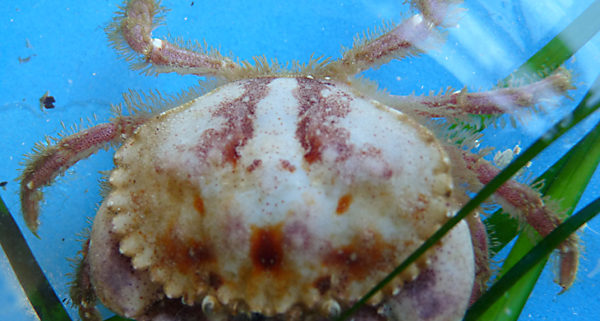Pygmy Rock Crab Author: Sam Mitchell-Joy Scientific name: Cancer oregonensis, Glebocarcinus oregonensis Common names: Pygmy Rock Crab, Hairy Cancer Crab, Oregon Cancer Crab Size range: A Pygmy Rock Crab can grow up to 5cm (2 inches) across its carapace. The males are larger than the females by about a centimeter. Identifying features: The Pygmy Rock Crab can be identified by its rounded shell with numerous spiny ridges and black tipped claws. Some larger and developing Pygmy Rock Crab have tubercles (rounded projections) that develop in patterns on their dorsum. Their legs are covered in small hairs called setae which are most easily identified under water. The dorsal surface and legs are usually a dull red but can be found in lighter colors such as browns and whites; the underside is most commonly white. Habitat: The pygmy rock crab lives intertidal to 436 meters deep. They are often found habituating crevices, under rocks, and the holes of dead barnacles. Often a male and a female will share a hole or crevice. Pygmy Rock Crab can be found up the Pacific coast of North America, ranging between southern Alaska and southern California. Prey: The Pygmy Rock Crab is a nocturnal feeder of small barnacles, small snails, molluscs, worms, and algae. Predators: The Pygmy Rock Crab is preyed upon by River Otters, Pacific Cod, and its relative the Red Rock Crab (Cancer productus). They hunt nocturnally to avoid crepuscular predators and they may use their rounded shell to block the entrance to protect themselves from predators who aim to grab them from their hole. When caught outside its hole, the crab will roll itself into a ball by tucking its legs in to avoid danger. They will often be found in the empty shell of the Giant Acorn Barnacle (Balanus nubilus) effectively blocking the hole with their carapace. Life Cycle: The breeding season of the Pygmy Rock Crab is in the summer months, and takes place after the female has molted. A male will often carry a female around who is going to molt in anticipation of the breeding process. A single male is sometimes found with several females during the summer breeding months. Females bearing eggs are found during the months between November and May. Photos by Sam Mitchell-Joy References: Adams, Mary Jo (December 5, 2005). “Cancer oregonensis (Pygmy rock crab)”. Intertidal Organisms EZ-ID Guides. Washington State University. Extension – Island County. Retrieved May 20, 2012 fromhttp://www.beachwatchers.wsu.edu/ezidweb/animals/Canceroregonensis.htm Dave Cowles (2005). “Glebocarcinus oregonensis (Dana), Schweitzer and Feldmann, 2000)”. Walla Walla University. Retrieved May 20, 2012 fromhttp://www.wallawalla.edu/academics/departments/biology/rosario/inverts/Arthropoda/Crustacea/Malacostraca/Eumalacostraca/Eucarida/Decapoda/Brachyura/Family_Cancridae/Cancer_oregonensis.html Jamieson, David (2008). Pigmy Rock Crab, Puget Sound Sea Life [www.pugetsoundsealife.com]. Retrieved May 20, 2012.http://www.pugetsoundsealife.com/puget_sound_sea_life/Pigmy_Rock_Crab.html Klinkenberg, Brian. (Editor) 2010. E-Fauna BC: Electronic Atlas of the Fauna of British Columbia[www.efauna.bc.ca]. Lab for Advanced Spatial Analysis, Department of Geography, University of British Columbia, Vancouver. Retrieved May 20, 2012 from http://linnet.geog.ubc.ca/efauna/Atlas/Atlas.aspx?sciname=Glebocarcinus%20oregonensis Jma
Interesting resources for research and photographer credit
Latest Projects
VicHigh Marine
Victoria High School
1260 Grant St.
Victoria. BC, Canada
V8T 1C2
Phone: 250-388-5456
Email: dsyoung@sd61.bc.ca





Leave a Reply
Want to join the discussion?Feel free to contribute!